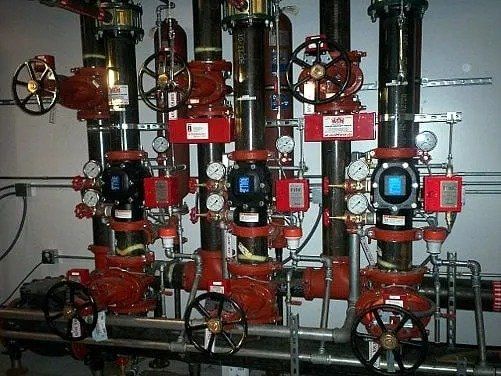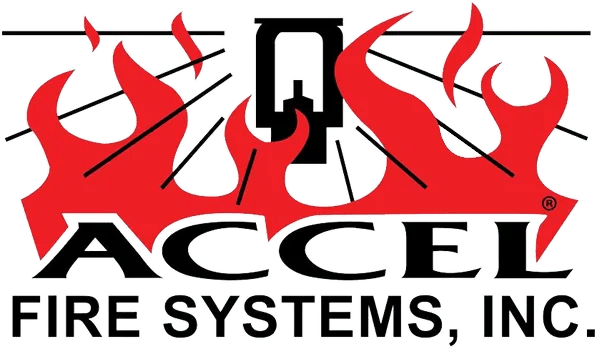EVERYTHING YOU NEED TO STAY SAFE
Due to the quick response time of a fire sprinkler system, fires are contained in small areas or extinguished completely, allowing occupants to evacuate without harm. This fast response means there is little damage to your building from firefighters attempting to control the fire.
Our team handles every aspect of your fire sprinkler system, from design and installation to repairs, maintenance, and testing. We also work with a variety of fire protection sprinkler styles, ensuring you get the right one for your property. In addition to water-based sprinkler systems, we also offer HEF foam systems, AFFF foam systems, high-expansion foam systems, and deluge fire systems.
Please see our sprinkler system FAQ below to learn more about the most common fire sprinklers and how they operate.

COMMON TYPES OF FIRE SPRINKLER SYSTEMS
- Wet Pipe Sprinkler System
- Dry Pipe Sprinkler System
- Preaction Sprinkler System
- Non-Interlock Pre-Action
- Single Interlock Preaction
- Double Interlock Preaction
- Deluge Sprinkler System
- Foam Sprinkler System
- Antifreeze Sprinkler System
SPRINKLER SYSTEM FAQ
WHAT ARE COMMON TYPES OF SPRINKLER SYSTEMS?
WET PIPE SPRINKLER SYSTEM
An automatic system in which water is under pressure within the entire system and directly behind all the sprinkler heads, so water discharge is immediate when the head is activated. This is the most commonly used sprinkler system.
DRY PIPE SPRINKLER SYSTEM
An automatic system in which air is under pressure within the entire system through the use of an air compressor. When the pressure is relieved, normally through an activated sprinkler head, loss of air allows water pressure to open a Dry Pipe Valve, allowing water to flow into the system and to the source of the fire. Dry pipe systems are installed when the system is exposed to cold temperatures, eliminating the possibility of freezing pipes. This is the second most commonly used sprinkler system.
PREACTION SPRINKLER SYSTEM
An automatic dry system with a supplemental detection system (smoke and/or heat detectors) is installed in the same areas as the sprinkler heads. In a normal situation, the preaction piping is filled with pressurized air. When a fire detector senses a fire, the alarm panel signals the preaction valve to open, and water flows in the system pipes. There are three distinct types of preaction systems:
NonInterlock Preaction
A noninterlock system admits water to sprinkler piping upon operation of either detection devices or the opening of automatic sprinkler heads. This type of preaction system is used much like a dry system to protect areas subject to seasonal cold weather. Still, the delay required to fill the piping with water only after a sprinkler head activates could allow the fire to build significantly. The detection system normally activates the preaction valve before the fire causes the sprinkler heads to open. By opening the preaction valve and filling the sprinkler pipe with water before the sprinkler head opens, the time elapsed before water is applied to a fire is greatly reduced to more closely imitate that of a wet pipe sprinkler system. This can use water to the fire as much as 60 seconds sooner than a dry pipe system, reducing the opportunity for the fire to develop large enough to cause greater damage or require a greater effort to be controlled.
Single Interlock Preaction
A single interlock system allows water to enter the sprinkler piping upon operation of detection devices. Water will still not discharge until one or more sprinkler heads have opened, presumably due to heat from a fire. The air pressure is used to monitor the integrity of the pipe in case of an accidental break to signify that repairs are needed to be made right away, so that when the detection system device activates the preaction valve and water enters the pipe, there won’t be water discharge until a fire opens the sprinkler heads. These are the systems typically used in computer rooms, archive rooms, or areas containing products or equipment that would be significantly damaged by accidental water discharge. These systems are also sometimes used as a backup to the gaseous clean agent system.
Double Interlock Preaction
A double interlock system admits water to a sprinkler system only upon the operation of both detection devices and automatic sprinkler heads. Requiring both the devices and the heads to activate provides the maximum assurance that the system will not accidentally fill with water. This system is most commonly used in commercial freezers where accidental water entry into the piping system could cause significant damage to the sprinkler system piping by freezing and busting it.
DELUGE SPRINKLER SYSTEM
An automatic system where all the heads are open is activated by a detection system (smoke and/or heat detectors). When a fire is detected, the control panel signals the deluge valve to open, allowing water to enter the system piping. The water will then flow out ALL of the sprinklers or nozzles. Since the heads are already open, heat is not required to open the sprinklers (as in the preaction system). Deluge systems are used in high-hazard areas where a fire tends to spread quickly. This system provides the advantage of quickly applying water over a large area.
FOAM SPRINKLER SYSTEM
Any of the previously described systems are connected to a special foam concentrate reservoir at the system riser that automatically delivers a combination of foam and water when the system is activated. This system is most commonly used in aircraft hangars or facilities that handle products that are flammable liquids or that become flammable liquids in a fire situation, such as petroleum, certain paints, solvents, fuels, etc.
ANTIFREEZE SPRINKLER SYSTEM
An automatic wet system in which the piping is filled with antifreeze instead of water to prevent freezing. When a head is activated by heat, the antifreeze solution is discharged, followed by water, operating like a wet system. Additionally, just a section of the system that is exposed to the cold can be designed to contain antifreeze and not the entire system. This is commonly used in overhangs, coolers, attics, etc.
CALL ACCEL FIRE SYSTEMS TODAY AT (907) 349-1490 TO SCHEDULE A CONSULTATION ABOUT THE FIRE SPRINKLER SYSTEM THAT’S RIGHT FOR YOU
ACCEL FIRE SYSTEMS, INC.
4510 Gambell St.
Anchorage, AK 99503
(907) 349-1490
mike@accelfire.com
